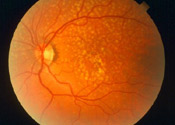 Age Related Macular Degeneration Age related macular degeneration (AMD) is one of the most common causes of poor vision after age 60. The visual symptoms of AMD involve loss of central vision. While peripheral vision is unaffected, one loses the sharp, straight-ahead vision necessary for driving, reading, recognizing faces, and generally looking at detail. Imagine being able to see a clock on the wall but unable to make out the time or unable to read because you could not see parts of words on the page.
Age Related Macular Degeneration Age related macular degeneration (AMD) is one of the most common causes of poor vision after age 60. The visual symptoms of AMD involve loss of central vision. While peripheral vision is unaffected, one loses the sharp, straight-ahead vision necessary for driving, reading, recognizing faces, and generally looking at detail. Imagine being able to see a clock on the wall but unable to make out the time or unable to read because you could not see parts of words on the page.
Although the specific cause is unknown, AMD seems to be part of aging in those who are genetically predisposed. While heredity is the most significant risk factor for developing AMD, high blood pressure, cardiovascular disease, and smoking have also been identified as risk factors. AMD accounts for most of the cases of new legal blindness in the US in those over the age of 60.
Nine out of 10 people who have AMD have the dry form, which results in thinning of the macula, the area of the retina responsible for central vision. Dry AMD takes many years to progress. Progress of dry AMD or the conversion to the more severe "wet" (or leaking) form may be prevented with the use of anti-oxidant vitamin (A,C,E) supplements with zinc, and lutein and omega-3 fatty acids (found in fish oil).
The wet form of AMD occurs much less frequently (one out of 10 people) but is more serious. Recently, a number of important advances have occurred in the diagnosis and treatment of wet AMD. At Advanced Vision Care, we use the latest in diagnostic techniques (including intravenous fluorescein angiography and optical coherence tomography) and treatment advances (including drug therapy with Avastin and Kenalog) to get the best possible results. It is now possible to improve the vision in many cases!
Low vision aids improve the quality of life in those with advanced dry AMD or wet AMD. The low vision program at Advanced Vision Care offers compassionate, extensive training with advanced technology devices to maximize an individual's functional capacity.